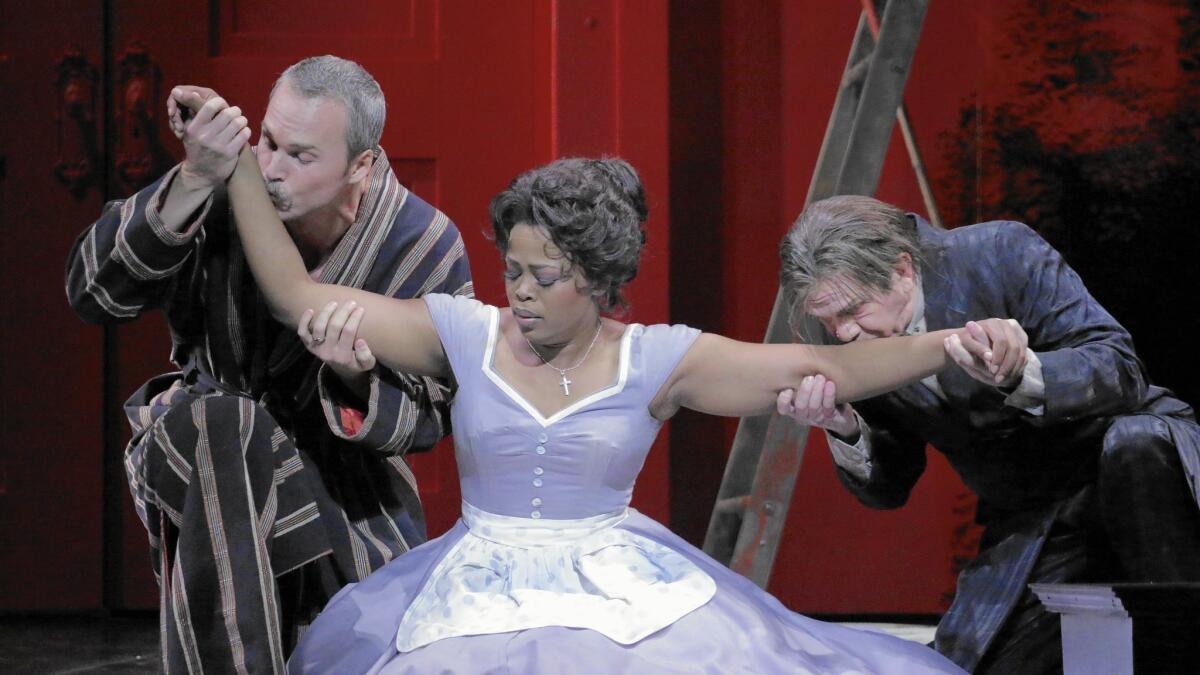Review: A by-the-book ‘Marriage of Figaro’ from Los Angeles Opera

- Share via
Los Angeles Opera’s journey through playwright Pierre Beaumarchais’ Figaro trilogy opened with John Corigliano’s expansion of Part 3 of the story, “The Guilty Mother,” in “The Ghosts of Versailles.” The company then doubled back to the beginning of the saga with Rossini’s “The Barber of Seville.” Finally, Part 2, Mozart’s “The Marriage of Figaro,” opened for business Saturday night at the Dorothy Chandler Pavilion.
What this amounts to is another genuine multi-opera cycle to go along with Wagner’s “Ring” in the repertory, and there are even interchangeable spare parts available — say, substituting Paisiello’s “Barber” for Rossini’s (which Long Beach Opera did in its 1989 Figaro cycle) or Milhaud’s “La Mère Coupable” for “Ghosts.”
This was the fourth time around for Ian Judge’s 2004 production of “Figaro” — last seen here in fall 2010 — and he was on hand to direct. Again, we were plunked down somewhere in the middle of the 20th century in Franco-era Spain, with a telephone for the Countess in Act 2, flashlights for the night-crawling cast in Act 4 and high-walled interiors of a palace that had seen better times.
Despite whisking the time frame ahead a couple of centuries, this remains pretty much a by-the-book “Figaro” that Mozart and librettist Lorenzo Da Ponte would have recognized as Judge continues to strike a good balance between knockabout comedy and underlying pathos. The physical attraction between Cherubino and the Countess was quite specifically spelled out, which would have left no doubt about what to expect in “The Guilty Mother.” The onstage fireworks after the close of the opera were startlingly noisier than I recall from previous performances — of course, guaranteeing a big hand from the audience.
This was the first time Music Director James Conlon had a crack at conducting this production, and it made a big difference. Conlon took the Overture at a comfortable yet exhilarating speed that felt just right, resisting the temptation to race through it breathlessly as others have. He explored the lyrical element underpinning the comedy, savoring the often exquisite counter-lines for winds and horns, getting generally splendid ensemble work from his musicians.
In a few passages, the orchestra and singers were a bit out of sync, and the energy level of the cast seemed to sag as the long, great Act 2 finale came to a head. But presumably, this will tighten later in the run, as these matters often do.
Just as characters reappear throughout Beaumarchais’ trilogy, so did the cast here. The Countess in “Ghosts,” Guanqun Yu, returned in that role in “Figaro,” delivering a steady, sincere “Dove sono” with a fast vibrato. Renée Rapier, the Cherubino in “Ghosts,” was Cherubino here too, with a small, lyrical voice appropriate for a teenage page.
After playing Dr. Bartolo’s housekeeper Berta in “Barber” (not to mention Susanna in “Ghosts”), Lucy Schaufer was another Bartolo cohort, Marcellina, in “Figaro,” playing up the comic aspects. Kristinn Sigmundsson (Louis XVI in “Ghosts,” Basilio in “Barber”) was the other three-timer in the cast, sneering and bellowing his Act 1 aria as Dr. Bartolo. Robert Brubaker (Bégearss in “Ghosts”) was a leering, unctuous Basilio.
Roberto Tagliavini displayed an imposing, carefully phrased bass-baritone as Figaro, but he wasn’t quite yet the presence that can dominate the stage. Pretty Yende’s smooth, crystalline-voiced Susanna hit the spot, while Ryan McKinny’s Count was a martinet with a somewhat-muted baritone. So Young Park was a steady, girlish Barbarina, Philip Cokorinos a typically befuddled Antonio, and Joel Sorensen (Wilhelm in “Ghosts”) a comic Don Curzio.
Because of “artist availability,” Conlon said in a pre-show talk, L.A. Opera understandably had to perform the Figaro cycle out of order, lessening the dramatic impression that would have come with following the Almaviva court saga from beginning to end. If these productions are ever revived — and why not, given how well attended and well received they seemed to have been — how about doing separate runs of each and then bringing them together consecutively in a week à la the “Ring” cycle?
For those who still can’t get enough of the Almaviva court, the indefatigable Conlon is leading two performances of Paisiello’s “Barber” — a pretty good piece, actually — with the USC Thornton School of Music Orchestra and members of the Domingo-Colburn-Stein Young Artists Program at the Los Angeles County High School for the Arts on April 10 and 11.
More to Read
The biggest entertainment stories
Get our big stories about Hollywood, film, television, music, arts, culture and more right in your inbox as soon as they publish.
You may occasionally receive promotional content from the Los Angeles Times.










